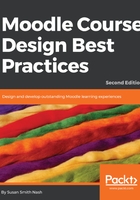
What this book covers
This is a quick-start guide to Moodle, a leading virtual learning environment for your online course. This guide incorporates principles of instructional design to show you how to develop and deploy courses, content, and assessment. We cover MoodleCloud and provide guidance using the latest default theme, Boost. There is a special emphasis on motivation, interactivity, and competency frameworks.
Chapter 1, Preparing to Build an Exemplary Moodle Course, brings together instructional design and the latest version of Moodle, with an emphasis on cloud-based Moodle for the most affordable and easily implemented solution. You will learn how to set up new courses using the principles of instructional design and also how to build the course to motivate students using cognitive psychology.
Chapter 2, Planning Your Course, allows you to build your course around learning outcomes and shows you how to connect Bloom’s taxonomy to the design of your course content, activities, and assessment. We also focus on accessibility and cover how to develop a course using Universal Design for Learning.
Chapter 3, Organizing Your Course, guides you in building a course framework centered on learning objectives. We use the responsive theme, Boost, which is the default theme in 3.5, and we will also discuss cloud-based MoodleCloud to show you how you can experiment in the cloud for free in order to truly customize your course design. We will discuss aligning the course with learning objectives, and we will take an inventory of tools and apps in order to match them with outcomes and student success strategies.
Chapter 4, Best Practices in Content Delivery, provides guidance in managing types of content and activities using cloud-based and on-premise theme, Boost. We will learn how to manage the different types of resources and activities and also how to use assessments to deliver content. We will develop strategies for incorporating collaborative learning, and we will include productivity and collaboration apps.
Chapter 5, Designing Self-Paced Independent Study Courses, incorporates how to set up and launch a course with resources, activities, and assessments that can be autonomous and self-guided. We will cover the new capabilities with MoodleCloud and apps that build in rewards and motivation by encouraging engagement and completion.
Chapter 6, Developing Cohort-Based Courses with Teacher-Student Interaction, allows you to set up a course that includes a group of students who interact with each other. You’ll be able to select the ideal content and activities for your group of students and design the course so that it motivates and encourages them to do their best work.
Chapter 7, Creating Student-Centered Project-Based Courses, demonstrates how to develop collaborative courses for groups, and it provides examples of ideal activities and resources. By using a project approach, you can incorporate portfolios and also take advantage of Moodle’s flexibility by encouraging students to collaborate with videos, podcasts, graphics, animations, presentations, and more.
Chapter 8, Moodle for Online Communities, emphasizes on collaboration and mission-based activities that are often completed by groups that are working together in an organization, professional society, or not-for-profit. There may be needs for certification or a need to collaboratively train people on safety, processes, and procedures. We will cover MoodleCloud and provide guidance using the latest default theme, Boost. There is a special emphasis on motivation, interactivity, and competency frameworks.